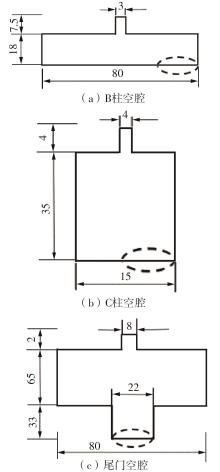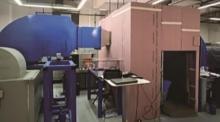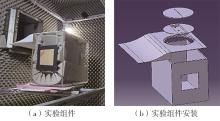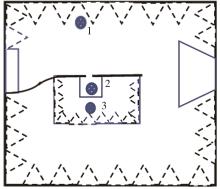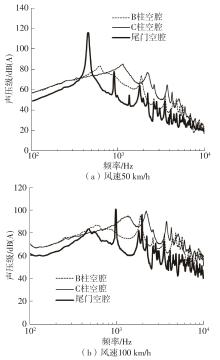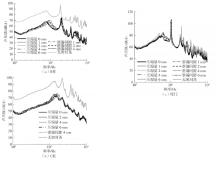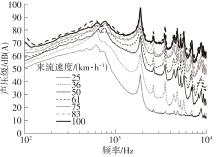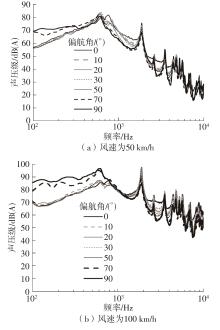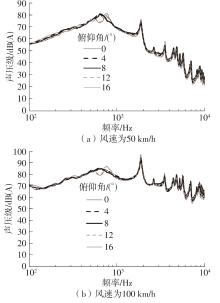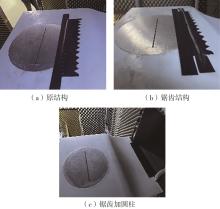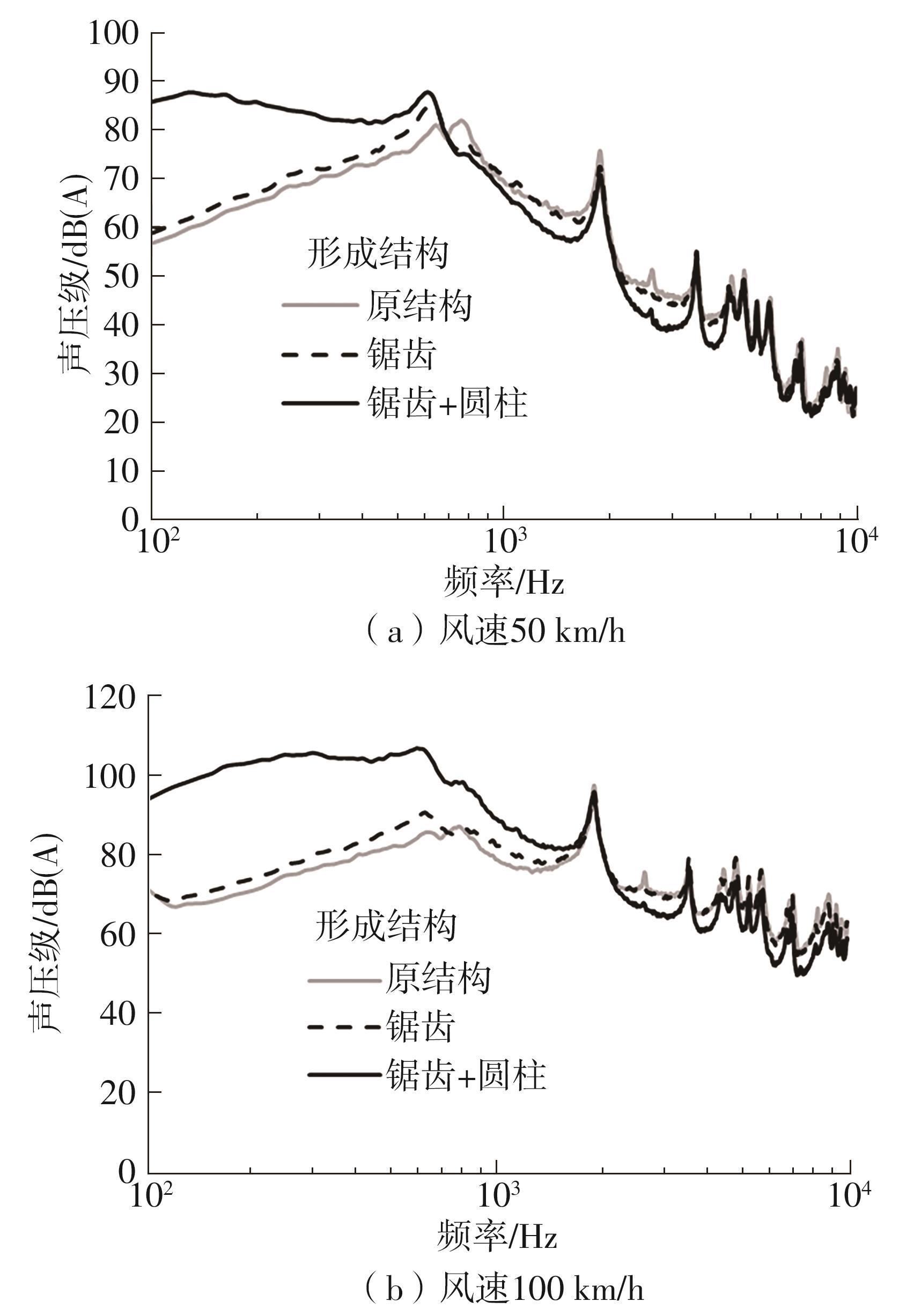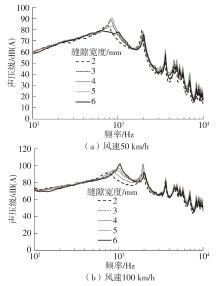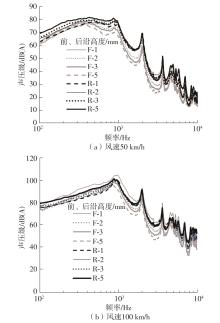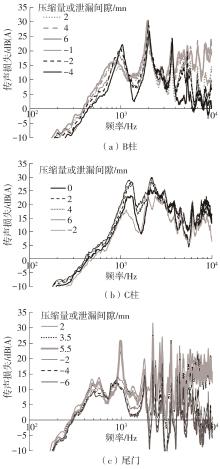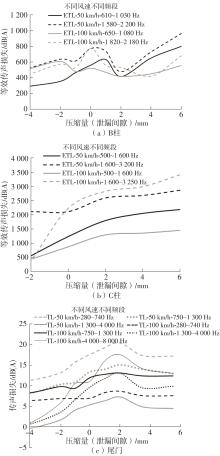Journal of South China University of Technology(Natural Science Edition) ›› 2024, Vol. 52 ›› Issue (9): 104-114.doi: 10.12141/j.issn.1000-565X.240023
Special Issue: 2024年交通运输工程
• Traffic & Transportation Engineering • Previous Articles Next Articles
Experimental Study on the Noise and Transmission of Automobile Door Sealing Cavity
ZHANG Binyu1,2( ), WANG Yigang1,3, YU Wuzhou4(
), WANG Yigang1,3, YU Wuzhou4( ), PENG Zining1,3, SONG Jun2, YE Bin2
), PENG Zining1,3, SONG Jun2, YE Bin2
- 1.School of Automotive Studies,Tongji University,Shanghai 201804,China
2.GAC Automotive Research & Development Center,Guangzhou 511400,Guangdong,China
3.Shanghai Key Lab of Vehicle Aerodynamics and Vehicle Thermal Management Systems,Shanghai 201804,China
4.School of Physics Science and Engineering,Tongji University,Shanghai 200092,China
-
Received:2024-01-11Online:2024-09-25Published:2024-04-12 -
Contact:俞悟周(1972—),女,博士,副教授,主要从事噪声与振动控制研究。 E-mail:ywzh@tongji.edu.cn -
About author:张斌瑜(1989—),男,博士,高级工程师,主要从事噪声与振动控制研究。E-mail: zhangbinyu2012@hotmail.com -
Supported by:the National Key R & D Program of China(2022YFE0208000)
CLC Number:
Cite this article
ZHANG Binyu, WANG Yigang, YU Wuzhou, et al. Experimental Study on the Noise and Transmission of Automobile Door Sealing Cavity[J]. Journal of South China University of Technology(Natural Science Edition), 2024, 52(9): 104-114.
share this article
| 1 | SAHA P, MYERS R D .Importance of sealants for interior noise control of automobiles[C]∥Proceeding of the SAE Technical Paper 920412.[S.l.]:[s.n.],1992:1-10. |
| 2 | GUR Y, MORMAN K N, SINDH N .Analysis of door and glass run seal systems for aspiration[C]∥Proceeding of the SAE Paper 971902.[S.l.]:[s.n.],1997:255-270. |
| 3 | 徐世文,王毅刚,杨小禹,等 .汽车车门密封结构的传声实验研究[J].声学技术,2021,40(3):385-392. |
| XU Shi-wen, WANG Yi-Gang, YANG Xiao-yu,et al. Experimental research on sound transmission of car door sealing structure [J].Technical Acoustics,2021,40(3):385-392. | |
| 4 | ROCKWELL D, NAUDASCHER E .Review-self-sustaining oscillations of flow past cavities[J].Asme Transactions Journal of Fluids Engineering,1978,100(2):152-165. |
| 5 | KOMERATH N M, AHUJA K K, CHAMBERS F W,et al .Prediction and measurement of flows over cavities-a survey[C]∥Proceeding of the AIAA Paper,25th AIAA Aerospace Sciences Meeting. Reno:AIAA,1987:166. |
| 6 | 顾晓卓 .某MPV前门区域风噪啸叫与密封优化分析[J].应用声学,2024(2):308-314. |
| GU Xiao-zhuo .Analysis of wind noise and seal optimization in front door area of an MPV[J].Journal of Applied Acoustics,2024(2):308-314. | |
| 7 | MONGEAU L, BEZEMEK J, DANFORTH R .Pressure fluctuations in a flow-excited door gap cavity model[C]∥Proceedings of the SAE Paper 971923.[S.l.]:SAE International,1997:2723-2729. |
| 8 | HENDERSON B S .Category 5:sound generation in viscous problems[C]∥Proceeding of the Fourth Computational Aeroacoustics (CAA) Workshop on Benchmark Problems 2004.Ohio:[s.n.],2004:71-77. |
| 9 | WANG Z K, GEORGI D, LAI C H,et al .Numerical simulation of flow-induced cavity noise in self-sustained oscillations[J].Computing and Visualization in Science,2007,10(3):123-134. |
| 10 | ROSSITER J E .Wind tunnel experiments on the flow over rectangular cavities at subsonic and transonic speeds [R].Farnborough:Royal Aircraft Establishment,1964. |
| 11 | MA R, SLABOCH P E, MORRIS S C .Fluid mechanics of the flow-excited Helmholtz resonator[J].Journal of Fluid Mechanics,2009,623:1-26. |
| 12 | ELDER S A, FARABEE T M, DEMETZ F C,et al .Mechanisms of flow-excited cavity tones at low Mach Number[J].Journal of Acoustical Society of America,1982,72(2):532-549. |
| 13 | LU W, LIN P, GUO H,et al .Flow parameters in dominant mode selection of self-excited oscillation in slat coves[J].AIAA Journal,2021,59 (8):3195-3208. |
| 14 | PARK J, SIEGMUND T, MONGEAU L .Sound transmission through elastomeric bulb seals[J].Journal of Sound and Vibration,2004,259(2):299-322. |
| 15 | PENG C, MA M .An investigation into the effect of door seals on noise generated in the passenger compartment[J].ImechE,1998,C521/1020:335-344. |
| 16 | GUR Y, MORMAN K N .Sound transmission analysis of vehicle door sealing system[C]∥Proceedings of the 1999 SAE Noise & Vibration Conference.Warrendale:[s.n.],1999:1187-1196. |
| 17 | 李奇,白长安,王勇 .汽车车门密封条隔声性能仿真分析方法介绍[J].声学技术,2014,33(S2):281-284. |
| LI Qi, BAI Chang-an, WANG Yong .Introduction of sound insulation performance simulation of vehicle door seals [J].Technical Acoustics,2014,33(S2):281-284. | |
| 18 | 王晓军 .汽车车内噪声与车身密封性的关系探讨[J].北京汽车,2011(2):30-32,35. |
| WANG Xiao-Jun .Exploration of the relationship between automotive interior noise and body sealing[J].Beijing Automotive,2011(2):30-32,35. | |
| 19 | 孙飞,梁波,刘建伟,等 .汽车车门密封性能控制与风噪声改善[J].噪声与振动控制,2015,35(2):82-86. |
| SUN Fei, LIANG Bo, LIU Jian-wei,et al .Seal performance control of automobile doors and wind noise reduction of vehicle[J].Noise and Vibration Control,2015,35(2):82-86. | |
| 20 | YANG Z G, YU H S, WANG Y G,et al .Application of immersed boundary-lattice boltzmann method in failure of automobile door sealing strip[J].Journal Automobile Engineering,2024,238(1):187-197. |
| 21 | LIU Y, LIU P Q, GUO H,et al . Investigation of the dominant rossiter modal tones at the locked-on state [J].Journal of Sound and Vibration,2023,556:117741/1-21. |
| 22 | WITTICH D .J,ALAN C B,JUMPER E,et al.Strong flow-acoustic resonances of rectangular cavities [J].Aeroacoustics,2011,10(2/3):277-294. |
| 23 | DALMONT J P, EDERVEEN C J N, OLY N J .Radiation impedance of tubes with different flanges:numerical and experimental investigations [J].Journal of Sound and Vibration,2001,244(3):505-534. |
| 24 | RONALD L .PANTON,JOHN M M.Resonant frequencies of cylindrical Helmholtz resonators [J].Journal of the Acoustical Society of America,1975,57:1533-1535. |
| [1] | YANG Yi, WANG Zhe, ZHANG Zhiyuan. LES Study on the Influence of Streamlined Accessories on the Wind Loads of TTU Model [J]. Journal of South China University of Technology(Natural Science Edition), 2025, 53(2): 136-148. |
| [2] | YANG Yi, WANG Xin, JI Changhui. Wind Tunnel Test Research on the Effect of Rough Strips on Wind Loads of A Super High-Rise Building [J]. Journal of South China University of Technology(Natural Science Edition), 2023, 51(4): 1-8. |
| [3] | ZHANG Xiang YAN Quansheng JIA Buyu LIU Muguang YU Xiaolin. The Study of Wind Tunnel Test and Numerical Simulation of Aerodynamic Interference on Adjacent Three Separated Deck Bridges [J]. Journal of South China University of Technology(Natural Science Edition), 2021, 49(12): 101-112. |
| [4] | YOU Yi YAN Zhitao LI Xinmin ZHONG Yongli HUANG Hanjie. Wind tunnel tests on drag coefficients of multiple-insulator strings [J]. Journal of South China University of Technology (Natural Science Edition), 2018, 46(9): 66-72. |
| [5] | HUANG Zundi LIANG Xifeng CHANG Ning YIN Zhichun HUANG Yuming ZHENG Jiongjie MO Guangxing. Optimization Research on Cross-section of Intercity EMU Body Based on LES [J]. Journal of South China University of Technology (Natural Science Edition), 2018, 46(9): 109-115. |
| [6] | HUANG Xian-feng YANG Zong-xiao. Prediction of Sound Transmission Through Diagonal Rooms Within a Residence Building [J]. Journal of South China University of Technology (Natural Science Edition), 2017, 45(12): 114-120,134. |
| [7] | Li Xiao-kang Xie Zhuang-ning Wang Zhan. Rapid Algorithm and Its Application of Wind-Induced Vibration Response of Super High-Rise Building Under the Control of Multiple Tuned Mass Dampers [J]. Journal of South China University of Technology(Natural Science Edition), 2012, 40(4): 118-124. |
| [8] | Zhu Bing-hu Zhang Qi-lin. Monitoring and Analysis of Wind Effect on Membrane Roof of Expo Axis [J]. Journal of South China University of Technology(Natural Science Edition), 2012, 40(2): 13-18. |
| [9] | Xie Zhuang-ning Liu Shuai Shi Bi-qing. Investigation into Wind Tunnel Test of Standard Low-Rise Building Model [J]. Journal of South China University of Technology (Natural Science Edition), 2011, 39(6): 106-112. |
| [10] | Xie Zhuang-ning Zhu Jian-bo. Distribution Characteristics of Mean Wind Pressure on Tall Buildings [J]. Journal of South China University of Technology (Natural Science Edition), 2011, 39(4): 128-134. |
| [11] | Xiao Zheng-zhi Li Zheng-liang Wang Zhi-song Yan Zhi-tao. Spatial Distribution Estimation of Wind Loads on Transmission Tower Based on High-Frequency Force Balance Tests [J]. Journal of South China University of Technology (Natural Science Edition), 2009, 37(6): 147-152. |
| [12] | Hou Jia-jian Han Xiao-lei Xie Zhuang-ning . Wind Load Characteristics of Twin-Tower Corridor-Connected Tall Building with Complex Shape [J]. Journal of South China University of Technology (Natural Science Edition), 2008, 36(3): 121-127. |
| [13] | Liu Yue-xing, Wang Fan, Wu Bo, et al. Wind Tunnel Test of Inclined Long-span Flat Roof in Complex Circumstance [J]. Journal of South China University of Technology(Natural Science Edition), 2004, 32(11): 75-80. |
| [14] | Fu J-i yang Gan Quan . Neural Network Models for Describing Characteristics of Wind Pressure Distribution on Large Span Flat Roof [J]. Journal of South China University of Technology(Natural Science Edition), 2003, 31(8): 62-66. |
| Viewed | ||||||
|
Full text |
|
|||||
|
Abstract |
|
|||||
